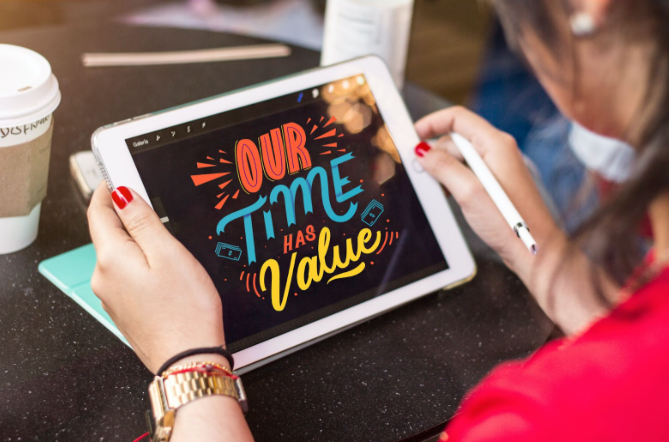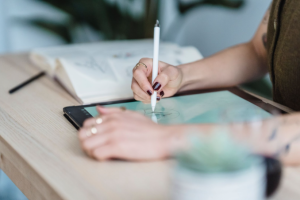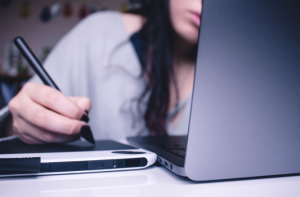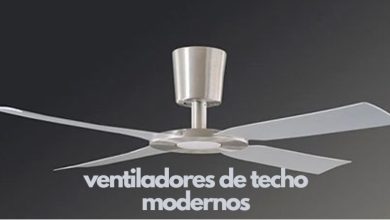
Image Source: Pexels.com
Almost every artist, graphic designer, animator, and illustrator wants to get their hands on the finest tablet for designing and art. It is one of the most addictive gadgets one can buy.
The term ‘tablet’ reminds us of the classic devices that we use as an alternative to computers and laptops. Even though graphic tablets share a resemblance with those gadgets, their use is comparatively different.
In today’s section, we will include two main types of tablets for design and art. Also, we will share some factors for you to consider before picking one for yourself.
Using a Tablet for Designing and Art

Image Source: Pexels.com
Technology has developed products in a way the feel of having a pen in your hand and drawing on a sheet does not get compromised. In fact, graphic tablets offer much more creative freedom and precision than traditional tools, thanks to their construction and software control.
The drawings made from the stylus appear on the computer screen in real time. Dedicated software such as Photoshop can help with necessary alterations and modifications afterward.
How to Choose the Best Accessories for Your Tablet
Main Types of Graphic Tablets
You will be able to choose the best drawing tablet for yourself once you know about its types. It will not only make your work easier but also enjoyable. Besides, it does not require you to sit in the office to implement your ideas; you can draw anywhere you feel inspired enough.
Tablets for designing purposes have two main categories:
- The first type has a sheet of paper as a work surface and does not have a screen of its own. A stylus might come in the pack or has to be purchased separately. The leads attached to it often have replaceable ends, differentiated by the degree of inclination or the ability to define sensitivity via the graphics tablet settings.
- The second type has a display, so your work will be visible directly on the tablet itself. Such tablets operate on the touch screen principle, just like classic tablets.
What are the Criteria for Choosing a Graphic Tablet for designing?
The one indispensable accessory for a professional graphic designer is their drawing tablet. So, here we have mapped out the criteria for choosing the best drawing tablet according to your needs and budget.
1. Screen Resolution
Details, neatness, and precision are the key ingredients to drawings and illustrations. Therefore, while selecting the tablet for designing, you have to know what resolution it provides. Some devices give a measure for resolution in pixels, and some in lines per inch.
The higher the resolution, the more precise details of your creation will be. Depending on the nature of your work, you can pick the right solution for you.
For instance, a simple logo design does not need to be as precise as fine art. In such cases, you use a more basic tablet with a lower resolution and save money.
2. Pressure Sensitivity

Source: Unsplash
Modern tablets can sense the varying depth of your stroke depending on how firmly you press the stylus. Pressure sensitivity varies with your tablet’s resolution, so some cheap models might not be as sensitive as expensive high-resolution ones.
Pressure sensitivity is crucial to those who want to achieve a certain level of precision in their drawings. On the contrary, people who use their graphic tablet for designing basic logos and sketches might not care about it much.
But the difference is too great that once someone gets used to a device with high sensitivity, they cannot swap it for low sensitivity.
3. Tracking Speed
By tracking speed, we mean the lag between a stylus stroke and the computer’s response to it. If you are a professional graphic designer who does art all day long, you want a tablet with higher tracking speed.
The measure for tracking speed is points per second (PPS). Graphic tablets with low PPS have poor quality and performance, including choppiness. That’s the least thing you want for your tablet for designing, that’s for sure.
4. Operating Software Compatibility
The operating system you use can restrict your options in graphic tablets. A few companies make devices compatible with almost all the leading operating systems, like Windows, Mac, and Linux.
As a current market leader, Wacom makes great tablets for designing that are compatible with all the popular graphic software titles and operating systems.
Above all, if your tablet has bundled software, it might cost more, but it will have a better potential value. However, some professionals do not think bundled software makes a huge difference.
5. Physical Properties
The construction materials of your tablet have significant importance because there is an advantage if the exterior contains more metals than plastics. But metal construction makes it heavier and attracts condensation in colder environments.
In addition, most people go by the rule that the bigger the tablet size, the better it is. However, this is not always true because smaller ones can provide you with higher resolution for the amount you spend to get a bigger size.
6. The Precision of the Stylus Pen
The criterion for choosing the stylus of a designing tablet is the same as the resolution; the higher, the more accurate. The optimal accuracy is 0.25mm, but even 0.5mm works fine if your work does not need extra details.
A more accurate pen means the finest details and detection of pressure levels. The objective of the stylus is to reflect your skills and capabilities accurately. A stylus like Huion Kamvas Pro GT-133 offers pressure levels up to 8,192, but even 1,024 levels are okay for amateur apps.
Lastly, it is crucial for the stylus to read the degree of inclination and movement of the hands.
You Know What’s the Best Part?
Uses of graphic tablets are not limited to drawing and creating diagrams; they have also made it easy to edit and retouch photos. The amount of precision and accuracy that a graphic tablet provides makes the editing even more exciting. Besides, these devices give you enormous control over your work, thus speeding up your workflow.
If you have never used a graphic tablet for editing before, you might be confused about buying it. The answer is yes, especially if you are a professional photographer who spends a lot of time working on photos.




